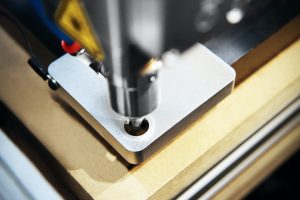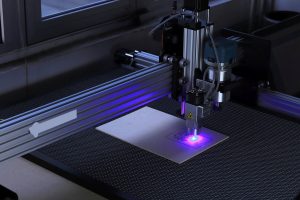Are you ready to embark on a creative journey that will leave your designs etched in brilliance? Look no further than the world of laser engraving and cutting! Whether you’re an artist, entrepreneur, or hobbyist, finding the perfect tool is crucial. That’s why we’ve partnered with xTool to bring you this comprehensive guide on choosing the right laser engraver or cutter. From precision to power, versatility to affordability, we’ve got all the key factors covered. Let’s dive into this fascinating realm together and discover the ultimate machine for unleashing your creativity!
Introduction to Laser Engraving and Cutting
Laser engraving and cutting is a popular and versatile method of creating precise designs on a variety of materials. It involves using high-powered lasers to burn or vaporize the surface of the material, resulting in intricate patterns, shapes, and text. This technology has revolutionized the world of crafting, manufacturing, and personalization by providing a fast and accurate way to produce highly detailed designs.
The process of laser engraving and cutting starts with designing or importing an image or pattern onto a computer software program. The design is then sent to the laser machine, which uses its powerful laser beam to etch or cut the material according to the programmed instructions. The intensity of the laser beam can be adjusted based on factors such as material type, thickness, and desired outcome.
One of the main advantages of laser engraving and cutting is its precision. The lasers used in this process are incredibly accurate, allowing for intricate details that cannot be achieved through traditional methods such as hand carving or printing. This makes it ideal for creating custom designs on various materials like wood, acrylics, glass, leather, paper, fabric,and more.
Another benefit of using laser technology for engraving and cutting is speed. Unlike other methods that may require hours or even days to complete a project, lasers can perform tasks quickly while maintaining high levels of accuracy. This means that you can efficiently mass-produce items without sacrificing quality.
Furthermore, laser engraving and cutting allows for greater versatility in design options compared to traditional methods.
Understanding the Different Types of Laser Engravers and Cutters
Laser engravers and cutters are versatile tools that use laser technology to create precise and intricate designs on various materials such as wood, acrylic, paper, fabric, and more. These machines have become increasingly popular in the fields of crafting, manufacturing, and prototyping due to their ability to produce high-quality results quickly.
However, with so many options available in the market, it can be overwhelming for beginners to choose the right laser engraver or cutter for their needs. To help you make an informed decision, let’s take a closer look at the different types of laser engravers and cutters available.
1. CO2 Laser Engraver/Cutter
CO2 lasers are the most common type of laser used in engraving and cutting machines. They work by emitting a beam of infrared light through a gas-filled tube which is then focused onto the material using mirrors. The focused beam heats up the surface of the material causing it to vaporize or melt away, leaving behind a clean engraved or cut mark.
CO2 lasers are suitable for a wide range of materials including wood, acrylics, leather, paper, and more. They offer high precision and speed making them ideal for small businesses or hobbyists looking to create detailed designs.
2. Fiber Laser Engraver/Cutter
Fiber lasers use a solid-state source – typically Ytterbium-doped fiber – instead of gas-filled tubes like CO2 lasers. This allows them to produce a much stronger beam which makes them perfect
Factors to Consider When Choosing a Laser Engraver or Cutter from xTool
When it comes to choosing a laser engraver or cutter, there are several factors that you need to consider in order to make the best decision. At xTool, we understand that investing in a laser machine is a big decision and we want to help you choose the right one for your specific needs. In this section, we will discuss some of the key factors that you should keep in mind when selecting a laser engraver or cutter from xTool.
1. Type of Laser Technology:
The first factor to consider is the type of laser technology used in the machine. There are three main types: CO2, fiber, and diode lasers. Each type has its own advantages and disadvantages depending on what materials you plan on working with. CO2 lasers are ideal for non-metallic materials such as wood, acrylic, and leather while fiber lasers are better suited for metal materials. Diode lasers are most commonly used for marking and engraving on smaller items like jewelry or electronics.
At xTool, we offer all three types of laser machines so it’s important to determine which one will be best suited for your specific projects.
2. Power Output:
The power output of a laser machine is measured in watts (W) and determines how powerful the beam will be. The higher the wattage, the more energy output and stronger cutting/engraving capabilities the machine will have.
Budget
When purchasing a laser engraver or cutter, it is important to consider your budget carefully. Laser machines can range in price from a few hundred dollars to tens of thousands of dollars. Therefore, it is crucial to determine your budget before beginning the buying process.
First and foremost, you should assess the needs and requirements for your specific project or business. If you are a hobbyist looking for a machine for occasional use, a lower-priced entry-level machine may be suitable for you. However, if you are running a business that requires constant and heavy use of the machine, investing in a high-end model may be more cost-effective in the long run.
Apart from the initial purchase price, it is essential to factor in other costs associated with owning and operating a laser engraver or cutter. These can include maintenance fees, replacement parts, software upgrades, and even training expenses if necessary. It is crucial to have an understanding of these additional costs and factor them into your budget.
Another aspect to consider when setting your budget is the type of materials you will be working with. Different materials require different types of lasers and cutting settings which can affect the overall cost. For example, cutting through thick wood will require more power than etching on acrylic or leather.
It’s also worth considering future growth when determining your budget for purchasing a laser machine. Will you need to upgrade or expand your machine capabilities in the future? If so, it may be more cost-effective to invest in a higher-priced model now rather than having
Material Compatibility
Material compatibility is an essential factor to consider when choosing the right laser engraver or cutter. Not all materials can be engraved or cut using the same type of laser machine, and using the wrong one can lead to poor results or even damage to your materials. In this section, we will discuss the different types of lasers and their capabilities, as well as how to determine which laser is best suited for your material needs.
There are three main types of lasers used in engraving and cutting machines – CO2, fiber, and diode. Each type has its own unique properties that make it suitable for specific applications.
CO2 lasers have a wavelength of 10.6 microns and are primarily used for engraving and cutting non-metallic materials such as wood, acrylic, leather, paper, and plastics. They are also capable of engraving on some metals with the use of a special coating.
Fiber lasers have a shorter wavelength (around 1 micron) than CO2 lasers and are mainly used for marking and engraving on metals such as stainless steel, aluminum, brass, titanium, etc. They are highly precise and produce permanent marks without damaging the surface of the material.
Diode lasers have a wavelength between 808-980nm and are commonly used for marking on plastics and certain metal surfaces. They offer high-speed marking but are not suitable for deep engraving or cutting.
Size and Power Requirements
When it comes to choosing the right laser engraver or cutter, one important factor to consider is size and power requirements. This aspect can greatly affect what type of machine you should invest in, as well as its capabilities and limitations.
Firstly, let’s talk about size. Laser engravers and cutters come in a range of sizes, from small desktop models to large industrial machines. The size of the machine you choose will depend on your specific needs and the space available in your workshop or studio.
If you are a hobbyist or have limited space, a smaller desktop model may be more suitable for you. These machines typically have a smaller working area but are still capable of producing high-quality engravings and cuts. They are also more affordable compared to larger industrial models.
On the other hand, if you run a business that requires high-volume production or need to work with larger materials, an industrial-sized laser engraver or cutter would be more appropriate. These machines have bigger working areas and can handle thicker materials such as wood, acrylic, and metal. However, they do come at a higher price point.
Aside from physical size, another important consideration is the power requirement of the machine. Laser engravers and cutters use different types of lasers such as CO2 or fiber lasers which require varying levels of power output measured in watts (W).
For lighter tasks like engraving on paper or leather, lower-powered lasers ranging from 30-60W will suffice. If you plan on cutting through
Software Compatibility and Ease of Use
When looking for a laser engraver or cutter, it’s essential to consider the software compatibility and ease of use. These two factors can greatly impact your overall experience with the machine and determine its suitability for your specific needs.
Software Compatibility:
The first thing to consider is the software compatibility of the laser engraver or cutter. This refers to the type of software that is compatible with the machine, as well as its ability to work seamlessly with different operating systems.
Most laser engravers and cutters come with their own proprietary software that is specifically designed for their machines. It’s important to check if this software is compatible with your computer’s operating system before making a purchase. If you have a Mac, for example, make sure that the software works on MacOS and not just Windows.
Additionally, some machines may also be compatible with third-party design software such as Adobe Illustrator or CorelDRAW. This allows you to create more intricate designs and gives you more flexibility in terms of design options.
Ease of Use:
The next factor to consider is how user-friendly the machine’s interface is. Laser engraving and cutting can seem intimidating at first, but a good quality machine should have an intuitive interface that makes it easy for even beginners to understand and operate.
Look for features like a touchscreen display or a user-friendly control panel that allows you to adjust settings such as speed, power, and depth easily. Some machines even come with pre-set templates and design options, making it easier for beginners to get started without having
Top Picks from xTool’s Collection of Laser Engravers and Cutters:
At xTool, we pride ourselves on providing high-quality laser engravers and cutters that are perfect for a wide range of applications. With our extensive collection of products, it can be overwhelming to choose the right one that meets your specific needs. That’s why we have narrowed down our top picks from our collection to help guide you in your decision-making process.
1. xTool Laser Engraver 1500
The xTool Laser Engraver 1500 is the perfect choice for those looking for a powerful and versatile machine. With a 1500mW laser power, this engraver can easily etch on a variety of materials such as wood, leather, acrylic, and more. Its large working area of 14x20cm allows you to work on bigger projects with ease. The engraving speed can also be adjusted up to 10 levels according to your preference.
2. xTool Desktop Laser Cutter 1000
For those who need a compact yet efficient laser cutter, the xTool Desktop Laser Cutter 1000 is an excellent option. Despite its small size, it has a cutting area of 30x40cm and a laser power of 1000mW making it suitable for various materials like paper, cardboard, rubber stamps, and more. It also comes with software that allows you to design and customize your projects before cutting.
3. xTool Fiber Laser Marking Machine
Features, Benefits, and Price Comparison
When looking for a laser engraver or cutter, there are several important factors to consider. One of the most crucial aspects is understanding the features and benefits of each machine, as well as comparing their prices. In this section, we will discuss the key features and benefits to look for in a laser engraver or cutter, as well as provide a price comparison between different models.
Features:
1. Laser Type: The type of laser used in an engraver or cutter can greatly affect its performance and capabilities. There are three main types of lasers – CO2, fiber, and diode – each with their own strengths and weaknesses. CO2 lasers are best suited for cutting thicker materials like wood and acrylics, while fiber lasers are better for precision cutting on metal surfaces. Diode lasers are more versatile and can handle a variety of materials but may have lower power output.
2. Power Output: This refers to the strength of the laser beam measured in watts (W). Higher power output means faster cutting speeds and deeper engravings on thicker materials.
3. Engraving/Cutting Area: The size of the working area determines the maximum size of material that can be engraved or cut by the machine. It is important to choose a machine with an adequate working area that meets your specific needs.
4. Software Compatibility: Most modern laser engravers/cutters come with software that allows you to create designs, control settings, and send them directly to the machine for printing/cutting. It is essential
Accessories for Versatile Laser
When it comes to using a laser engraver or cutter, having the right accessories can greatly enhance its versatility and functionality. In this section, we will discuss some of the essential accessories for a versatile laser.
1. Rotary Attachment:
A rotary attachment is a useful tool that allows you to engrave cylindrical objects such as bottles, glasses, and pens with precision. It works by rotating the object while the laser beam stays stationary, ensuring an even and consistent engraving on curved surfaces. This accessory is ideal for businesses that offer personalized products or services.
2. Honeycomb Table:
A honeycomb table is a perforated metal bed that sits below the material being engraved or cut. Its purpose is to provide ventilation and support for materials that may bend or warp under high heat from the laser beam. The holes also allow debris to fall through, keeping the work surface clean and reducing fire hazards.
3. Air Assist Compressor:
An air assist compressor is crucial for cutting materials like wood and acrylic as it blows away smoke and debris created during cutting. This not only keeps your workspace clean but also helps improve cutting quality by preventing any charring or discoloration on the edges of your material.
4. Fume Extractor:
A fume extractor is another important accessory for safety reasons when using a laser cutter or engraver in an enclosed space. It works by sucking up fumes produced during cutting or engraving, effectively removing them from your working environment.
5. Laser Alignment Tool:
A laser alignment tool is used to ensure that the laser beam is perfectly aligned with the material being engraved or cut. This accessory is especially useful for precise and detailed work, as any misalignment can result in inaccurate engravings or cuts.
6. Lens Cleaning Kit:
Regularly cleaning your laser lens is essential for maintaining the quality of your engravings and cuts. A lens cleaning kit usually includes a lens cleaner solution, lint-free wipes, and swabs, making it easy to keep your lens clean and free from dust or debris.
7. Vector Grid Mat:
A vector grid mat is a thin rubber mat that sits on top of your work surface and provides a protective layer between the material you are working on and your machine’s bed. It helps prevent damage to both your machine’s bed and your material during cutting or engraving.
These are just some important accessories that can greatly enhance the functionality of your laser engraver or cutter. Depending on your specific needs and projects, there may be other accessories that would be beneficial to have as well. Be sure to do thorough research and consult with experts before purchasing any accessories for your laser machine.







